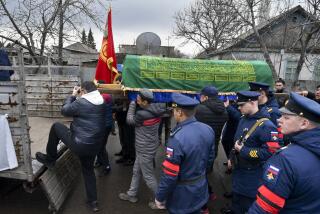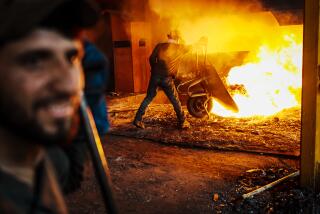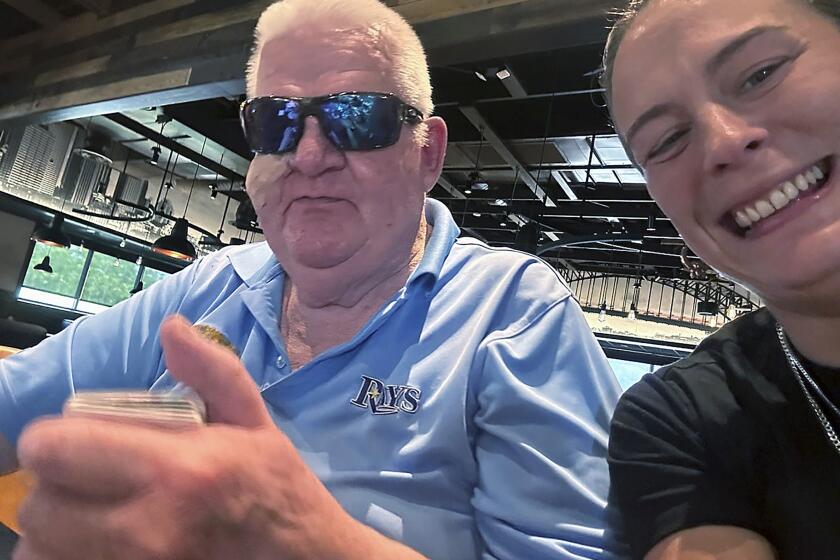Mystery Russians Unload Guns in Kabul
KABUL, Afghanistan — A man who spoke Russian entered a store in the bazaar, opened a black briefcase and produced an automatic weapon.
After several minutes of negotiation, the shopkeeper paid him 200,000 afghanis, or $500, for the gun. When a reporter approached him in the street seconds later and addressed him in English, the man got into a green jeep without license plates and drove away.
Who was this man?
Merchants said he and dozens like him identify themselves as Soviet soldiers. Since the Soviet withdrawal was completed Feb. 15, they say, those “soldiers” have sold them at least 20 automatic weapons.
Where the men are stationed, or what they are doing here, the shopkeepers can only guess.
Diplomats from countries with close ties to the Soviet Union say the only Red Army soldier in Afghanistan is the embassy military attache. They say all the others left in February.
The Afghan government’s position on the issue has not been clear. On Oct. 14, the official news agency Bakhtar reported the presence of Soviet military advisers in Kabul.
It added that they “only handle deliveries of arms and provide information on the specifications of arms and ammunition to the Afghan side, and do not take part in military operations at all.”
A day later, government spokesman Mohammed Nabi Amani said the Bakhtar report was “an error,” that there were no Soviet soldiers in Afghanistan.
Another government official quoted an Afghan military officer as saying Soviet soldiers operated a missile base on the outskirts of Kabul. He said the Soviets were unwilling to train Afghan soldiers to use the Scud rockets they provide, which require advanced tracking methods and use of computers.
More than 1,000 Scuds have been fired and the government has credited them with important victories over Muslim guerrillas, according to diplomats in Kabul and neighboring Pakistan.
A U.S. intelligence report has alleged that Soviets in Afghan uniforms operate the Scud base.
Many diplomats discount the report and say Soviet soldiers no longer are engaged in combat in Afghanistan. Some add, however, that Soviet officers direct the civil war and the operations of KHAD, the Afghan intelligence and secret police agency, at the Defense and Interior ministries.
An East Bloc journalist who visited the Defense Ministry frequently said he discovered Soviet advisers in several departments.
“Any country that is supplying billions of dollars a year to another country is not going to sit by and let that country direct its war effort,” one diplomat said.
Such influence by the Soviets over Afghanistan’s security, politics and economy has created problems between the two governments.
Afghan officials say privately that Soviet officials tend to treat them like colonial subjects, and a recent incident illustrates the point.
Journalists were taken to a battlefield to see captured weapons. A Soviet bodyguard armed with grenades, an assault rifle and seven clips of ammunition accompanied a Soviet television crew.
During the helicopter flight to Lalandar, 12 miles south of Kabul, the bodyguard, dressed in blue jeans and a combat jacket, ordered an Afghan officer to give up his seat and barked commands to the pilot.
When a Swiss journalist snapped his photograph, the guard grabbed the camera and exposed the film.
The journalist appealed to officials from the Foreign Ministry, who said they could do nothing. The ministry later protested to the Soviet Embassy.
And the question still remains: Who was the man in the bazaar?
More to Read
Sign up for Essential California
The most important California stories and recommendations in your inbox every morning.
You may occasionally receive promotional content from the Los Angeles Times.










